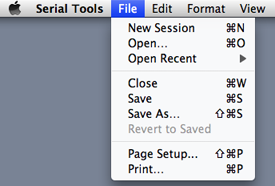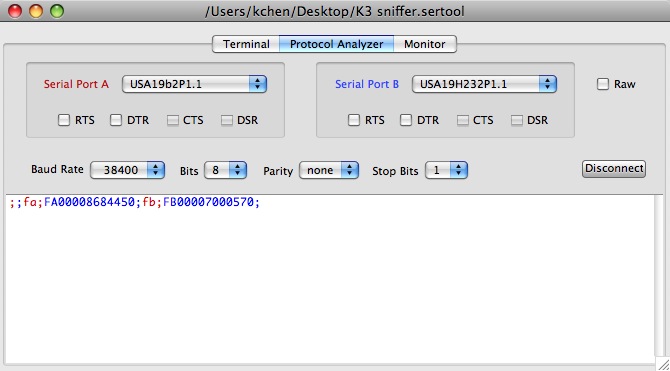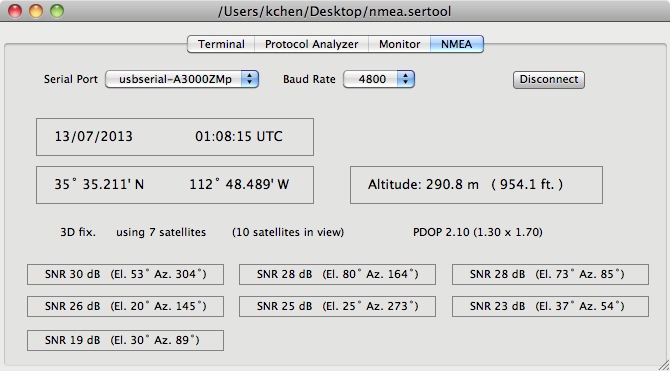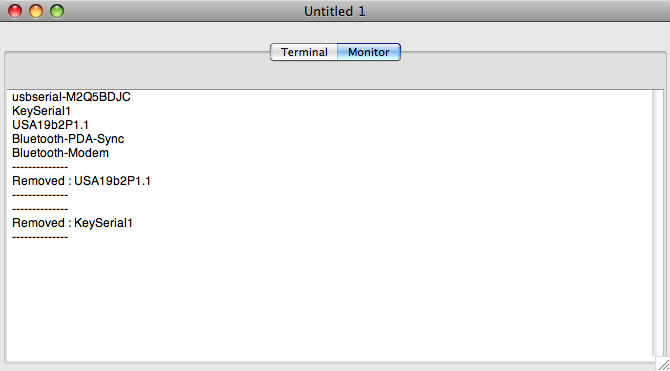![]()
Serial Tools
Kok Chen, W7AY [w7ay (at)
arrl (dot) net]
Last updated: July 13, 2013
Introduction
Serial Tools is a set of serial port tools for Mac
OS X. It includes a Terminal Emulator, a Protocol Analyzer,
an NMEA parser and a serial port monitor to watch for
connections and removals of serial ports.
Please note that Serial Tools is not a supported product,
but simply a project that I wrote for myself to use. If you
have similar needs, Serial Tools is completely free. The
Xcode project for Serial Tools and the sources are also
free.
Serial Tools is built as a Universal Binary application and
works natively with both the PowerPC and the Intel based
Macintosh running Tiger (Mac OS X 10.4) or newer. You can
download both the Serial Tools application and Xcode
project from the Download page. The sources in
Serial Tools are GPL free, and you have the freedom to
make any changes that you want without needing to
publish your changes.
The terminal emulator (Terminal.m) in Serial Tools is an
Objective-C extension of NSTextView class. It can be used
as sample code for any Cocoa application that needs to
communicate with a Mac OS X serial port through a text
view. For example, the protocol analyzer in Serial Tools is
just a sub-class of Terminal.m that supports a second
serial port connection.
Sessions
A Serial Tool session consists of a set of
port-specific preferences (baud rate, parity, etc) that can
be saved and re-opened at a later time.
After launching Serial Tools, you can select a New
Session or open an existing session file. You can also
launch Serial Tools by double clicking on a previously
saved Session file. Multiple sessions can be concurrently
opened, each one connected to a different serial port.

Each session can be Saved (or Saved As a file with a
different name). The saved file is a Cocoa dictionary
(similar to a plist file) with the properties of the
session. The saved file has an sertool extension.
Double clicking on a sertool file will launch
Serial Tools if the application is not already running.
Serial Tools uses the sertool file to open a new
session that has the parameters of the saved session.
When you select New Session, a new untitled Serial
Tools session window will appear.

Once you save the session under a name, the title bar of
the session window will inherit the same name. Likewise, if
you open a session using a previously saved session file,
the title bar of the session window will have the name of
the session file. Recent session files can be found in the
Open Recent menu item of the File menu.
Currently, the Serial Tools application contains three
tools, a Terminal Emulator (shown above), a Protocol
Analyzer (next figure below) and a Connections Monitor.
Terminal Emulator
When the session window is tabbed to the Terminal tab, you
will see the window that is previously shown above.The
Serial Port popup menu lets you select the serial port to
use. In the above, a KeySpan USB serial PDA adapter has
been selected.
Please note that the serial adapter from some
manufacturers can show up more than once under different
names in the Serial Port menu. If the device driver
registers the device under more than one name, both will
appear in the Serial Port menu. You can select either one.
You can choose the baud rate, the number of data
bits, whether to use even or odd or no parity and the
number of stop bits in the async protocol. Your selection
also shows up as a common designation, as in "9600 / 8-N-1"
above.
Click on the Connect button to open a
connection to the serial port. The button caption will
change to Disconnect. If you click on
Disconnect, you will close the connection
to the serial port and allow other apps to gain full
control of the serial port again.
Once connected, the CTS and DSR indicators will show the
status of those two RS-232 control lines. You can also
assert either RTS or DTR by clicking on their checkboxes.
When a serial port is disconnected, the RTS and DTR
checkboxes and the CTS and DSR indicators become inactive.
The textview below the menus and buttons is a half duplex
(what you type is immediately echoed to the text view)
"terminal emulator." Anything you type will go out through
the serial port, if it is connected. Anything that the
serial port receives will also appear on this text view.
When the cr/lf checkbox is selected, each
newline (return or enter keyboard key)
will cause an ASCII carriage return character and a
linefeed character to be sent.
When the Raw checkbox is selected, ASCII
control characters (less than 0x20 or greater or equal to
0x7f) will be printed as two hex digits in between angle
brackets. This option can help diagnose the difference
between 8-bit-no-parity and 7-bit-with-parity settings.
Protocol Analyzer
The Protocol Analyzer (port sniffer)
allows you to monitor the traffic between an existing
DTE-DCE connection. This can, for
example, be an existing connection between a computer
and a TNC. Another example is a connection between a
microKeyer and a transceiver's CAT port.
The Protocol Analyzer in Serial Tools works in conjunction
with two serial ports. One serial port is connected to the
DTE (with an appropriate null modem, if required) and the
other serial port is connected to the DCE.
Any character that is received by the serial port that is
connected to the DTE is printed to the text view and also
relayed to the serial port that is connected to the DCE.
Likewise, any character that is received from the DCE port
is relayed by Serial Tools to the DTE port and also echoed
to the text view.
The following figure shows the Protocol Analyzer that is
connected to intercept data which are flowing between a
different computer and an Elecraft K3. The red text (serial
port A) shows the characters that are sent from the second
computer, and the blue text (serial port B) are the
responses from the K3 transceiver.

NMEA (GPS) Monitor
The NMEA tab view displays information from the GGA, GSA,
GSV and RMC packets of an NMEA data stream from a serial-port
connected GPS device. The NMEA panel is developed with
an SiRF III receiver, but should work with other GPS
devices.

Select the serial port and baud rate and click on the
Connect button.
Date information is extracted from RMC packets. Time
information, latitude and longitude data are extracted from
both RMC and GGA packets. The GGA packet also provides
Altitude information.
The GSA packet provides information on the fix (no fix, 2D
fix or 3D fix) and dilution of precision (PDOP). The
horizontal dilution of precision (HDOP) and vertical
dilution of precision (VDOP) are shown in parenthesis
after the PDOP value.
The GGA packet provides information on how many satellites
are being tracked.
GSV packets provide information on how many satellites are
in view. Up to 9 of the satellites in the GSV packets are
listed in Serial Tools in the order of descending signal to
noise ratio. Together with the satellites' elevation and
azimuth, these are shown in boxes at the bottom part of the
window.
Connections Monitor
The Monitor tab view shows the connections to serial ports
on your computer.

As shown above, it lists all devices on your computer that
are registered to be serial devices. In addition, the
monitor "listens" for any notification when a device is
added or removed. The window below shows the display when
the Keyspan is disconnected from its USB hub:

Notice that the Monitor shows two device removals. This is
because the Keyspan driver has registered the Keysan PDA
adapter as both KeySerial1 and as
USA19bP1.1.
When the Keysan PDA adapter is plugged back into the USB
hub, this is what is shown in the Monitor:

With a new device set up, where you are not sure what a
serial port's name is, you can use the Connection Monitor
to watch for port activity as you physically add or remove
the device.
If there is no activity in the Connection Monitor when you
add or remove the device, you are most likely missing the
device driver.
Saving a Session
When you use the Save menu item in the File menu
on an Untitled session (or if you use the Save
As... menu item on any session), you will be shown a
dialog to provide a name for a session file and where to
save it to. This should create an XML file (pretty much
like what a plist file contains, and can be likewise opened
using the Mac OS Property List Editor that is on
the Developer disk) with a sertool file extension.
The Finder icon will look like this:

If you click on a previously created session file, Serial
Tools will create a new session with the parameters
determined by the file. If Serial Tools is not running,
double clicking on a Session file will also launch Serial
Tools for you.